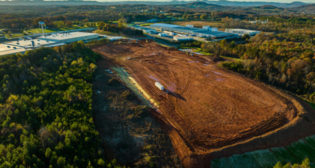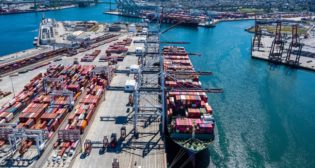
Railway Age’s 2013 Regional Railroad of The Year: Montana Rail Link
Written by William C. Vantuono, Editor-in-Chief“Our vision is to be the ‘Best of the Best’ in safety, customer service, and ingenuity,” says President Tom Walsh. “As a leader in the short line community, much of our success can be attributed to the passionate commitment exhibited by our employees towards that vision.”
Walsh describes how MRL has achieved significant improvements in six key areas: safety, customer service, innovation, enhanced productivity, community involvement, and employee satisfaction:
“The safety of our employees and the general public is paramount at MRL. Our safety goal is Double Zeroes—zero injuries and zero accidents. We finished 2011 with a 0.62 injury-frequency ratio, our best ever—a 36% improvement over the previous record set in 2010 and an 80% reduction from 2009. This positive trend is evidence of the strong safety culture our entire team has worked diligently to build. The MRL core values of Fairness, Integrity, Respect, Safety, and Trust (F.I.R.S.T.) are exemplified in the daily actions of our employees, who have a clear understanding that if their personal safety or the safety of their team is at risk, they will not proceed until the risk has been mitigated. With this principle as the foundation, we have built our safety culture to stand the test of time. We can say beyond any doubt that the success we have experienced in safety is the result of the care our employees demonstrate for themselves and their teammates. It cannot be attributed to luck.
“Excellence in customer service is a badge of honor worn by all MRL employees of Montana Rail Link. In recent years, we have seen a steady growth in tonnage from BNSF. Their confidence in sending trains across MRL is due to our proven ability to move freight safely and efficiently, and it exemplifies the strong relationship we shave. We have become a reliable partner with BNSF, not only in the routing of normal traffic, but also in times of hardship, in taking on re-routes when they encounter service interruptions.
“In 2011, severe flooding created impassable conditions on BNSF territory. Over a three-week period, they requested our assistance in detouring 166 trains. The detours, when coupled with our normal traffic flows, represented a record number of trains across our system. Our dedicated employees rose to the occasion to lend a hand to our largest business partner and completed the task successfully and safely.
“Montana rail shippers were not immune to the recent recession. Customers across all commodity groups suffered, with the forest products industry being most affected. Between 2008 and 2010, several major Montana mills closed their doors, including Stimson Lumber in Bonner (once the largest plywood mill in North America) and Plum Creek Lumber in Pablo. On the heels of these closures, Smurfit Stone Container announced the closure of its Frenchtown mill, once our largest customer. With the closure of these three mills and the loss of more than 13,000 carloads, we found ourselves with more than 170 log cars and 100 wood chip cars sitting idle. Without these local markets, Montana’s logging infrastructure—including loggers and truck drivers—was at risk.
“We began developing additional markets in 2010 for Montana’s forest products in an effort to put our idle assets and Montana loggers back to work. Our attention immediately turned to the international demand for finished lumber, saw logs, and wood chips. Some of our early work involved contacting paper mills in Japan to initiate discussions on fiber supply. To accomplish this, we hired University of Montana Japanese exchange students to make the calls. After countless attempts, we received our first lead. We began learning more about international demand and, then introduced potential buyers to Montana suppliers.
“Our first success involved pulp log shipments to Longview, Wash., in 2011. Soon after, we began working with Tricon Timber to supply its St. Regis, Mont., mill with logs from locations across our railroad. The logs are milled and shipped to the West Coast on centerbeams and exported to China. The finished product provides concrete forms for homes to be built for the growing middle class on China’s urban coast. In 2011, MRL shipped over 1,400 carloads for Tricon’s export program.
“Additional new business included shipment of wood pellets from Superior, Mont., to Vancouver, B.C; from Vancouver the pellets are exported to markets in Europe. We also signed a multi-year contract with Boise, Inc., to provide wood chips to their Wallula, Wash., paper mill. The chip mill will be located at the former Stimson Lumber mill site. Currently, 50 to 60 log loads per day are delivered to the chip mill for processing and shipment by rail to Wallula. Many in the Montana forest products community believe this project will save the logging industry in Western Montana.
“Ingenuity has been a cornerstone for MRL’s continued success in business and safety. Employing new technologies as well as evaluating long-standing procedures and products has resulted in long-lasting benefits. Not long after MRL operations commenced in 1987, we became the first and only railroad to reduce operating crews to two members, both being certified engineers. In 2000 we collaborated with the FRA and the BLET to introduce remote control locomotives, becoming one of the country’s first railroads using this technology in large-scale switching operations.
“In an effort to augment switching safety at our two major terminals, we again led the industry in 2004, installing GE’s Hydra-Switch technology on our major switching leads. This technology reduced the risk exposure of injuries and accidents associated with hand-lining switches, and it expanded the functional work time for each switch crew. In recent years, we have streamlined our fueling process for unit trains by fueling direct to the locomotives without cutting off the power to take to the roundhouse.
“We take great pride in our track and equipment maintenance program, while keeping that work on property almost exclusively. Our Engineering Department takes a proactive approach to maintenance by investing in large annual capital improvements in ties, rail, bridges, and signal systems, all of which are maintained to Class I standards. Our own maintenance-of-way forces do nearly all track maintenance and upgrades; this includes everything from out-of-face steel and tie renewal to undercutting, thermite welding, and production surfacing. The Mechanical Department’s roundhouse employees maintain and service the core fleet of locomotives that includes EMD SD70Ace, SD45-2, SD40-2, SD35, GP9, and SW1200 units. We regularly perform major overhauls and rebuilds. Locomotive availability is near 93%, even though 50% of the locomotive fleet is more than 40 years old.
“MRL continually evaluates procedures and operating practices to seek reductions in fuel usage and emissions. In recent years, our fleet size decreased from an average of 77 in-service locomotives to 51, even as traffic continued to increase. Using computer simulations, we were able to reconfigure our helper sets to achieve significant fuel savings without time loss on our mountain grades. In 2009, we began installing Ecotrans and Hotstart systems in our fleet to reduce engine run time when not in active service, again reducing fuel consumption and unnecessary emissions. Taking advantage of today’s technology, MRL and the City of Missoula formed a partnership, equipping some of the older locomotive fleet with idle reduction equipment to further reduce fuel use and emissions. Using computer simulations in the helper districts and combining old and new locomotives led to better locomotive utilization and increased fuel savings.
“Being environmentally responsible is one way we build and maintain good neighborly relationships with our on-line communities and ranchlands, keeping in mind that the well-being of the communities we serve increases their opportunities to prosper, and potentially opens doors to new business partnerships. Although we operate on a large scale, we strive to keep interactions personal, maintaining an open-door policy for anyone from our communities or bordering landholders who seeks to voice comment or concern, all while working to foster trust and ensure safe operations.
“MRL employees are a dedicated and highly skilled group. We have the good fortune of employing nearly 1,000 people who are loyal and passionate about their work. In order to maintain a high level of fairness and trust throughout the company, our managers and supervisors participate in sessions that focus on their personal development as leaders within our organization. Leadership MRL is the latest in a series of offerings designed for managers to identify strengths and focus on areas of personal growth.”



